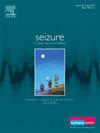杏仁核病变可能损害颞叶癫痫患者的情绪识别:一项初步研究的结果
IF 2.7
3区 医学
Q2 CLINICAL NEUROLOGY
引用次数: 0
摘要
目的颞叶癫痫(TLE)患者存在基本情绪识别缺陷。尽管许多影像学研究表明杏仁核在情绪识别中的重要作用,但缺乏对有和没有杏仁核病理(AmyD)的TLE患者进行比较的研究。本研究的目的是比较这些亚组患者的TLE。方法选择25例TLE患者(12例伴有AmyD, 13例无AmyD)和24例健康对照(CG),分别进行基本情绪表情逐渐变化的动画变形任务。在一项听觉任务中,受试者们听着用不同的情感韵律说出的中性句子。结果与CG相比,samyd患者的韵律识别和形态任务表现明显下降。与没有AmyD的患者相比,患有AmyD的患者表现出更差的韵律识别能力。结论本研究中,只有杏仁核病变的TLE患者存在视觉和听觉情绪识别障碍。这些结果为两种模式下完整的杏仁核在TLE中对基本情绪处理的重要性提供了初步证据。这些发现需要在更大样本的研究中得到证实。本文章由计算机程序翻译,如有差异,请以英文原文为准。
Amygdalar lesions may impair emotion recognition in patients with temporal lobe epilepsy: Results from a pilot study
Purpose
Deficits in basic emotion recognition have been documented in temporal lobe epilepsy (TLE). Although numerous imaging studies have suggested a critical role for the importance of the amygdalae in emotion recognition, investigations comparing TLE patients with and without amygdalar pathology (AmyD) are lacking. The goal of the present study is to compare these subgroups of patients with TLE.
Methods
Twenty-five patients with TLE (12 with AmyD, 13 without amygdalar pathology (no AmyD)), and twenty-four healthy controls (CG) performed an animated morph task with faces showing basic emotions gradually changing in their emotional intensity. In an auditory task, subjects listened to neutral sentences spoken with varying emotional prosody.
Results
AmyD patients showed significantly reduced prosody recognition and morph task performance compared to CG. Patients with AmyD showed worse prosody recognition performance compared to no AmyD.
Conclusion
In the present study, only TLE patients with amygdalar pathology showed deficits in visual and auditory emotion recognition. These results provide preliminary evidence for the importance of intact amygdalae in TLE for basic emotion processing in both modalities. The findings need to be confirmed in studies with larger samples.
求助全文
通过发布文献求助,成功后即可免费获取论文全文。
去求助
来源期刊

Seizure-European Journal of Epilepsy
医学-临床神经学
CiteScore
5.60
自引率
6.70%
发文量
231
审稿时长
34 days
期刊介绍:
Seizure - European Journal of Epilepsy is an international journal owned by Epilepsy Action (the largest member led epilepsy organisation in the UK). It provides a forum for papers on all topics related to epilepsy and seizure disorders.
 求助内容:
求助内容: 应助结果提醒方式:
应助结果提醒方式:


